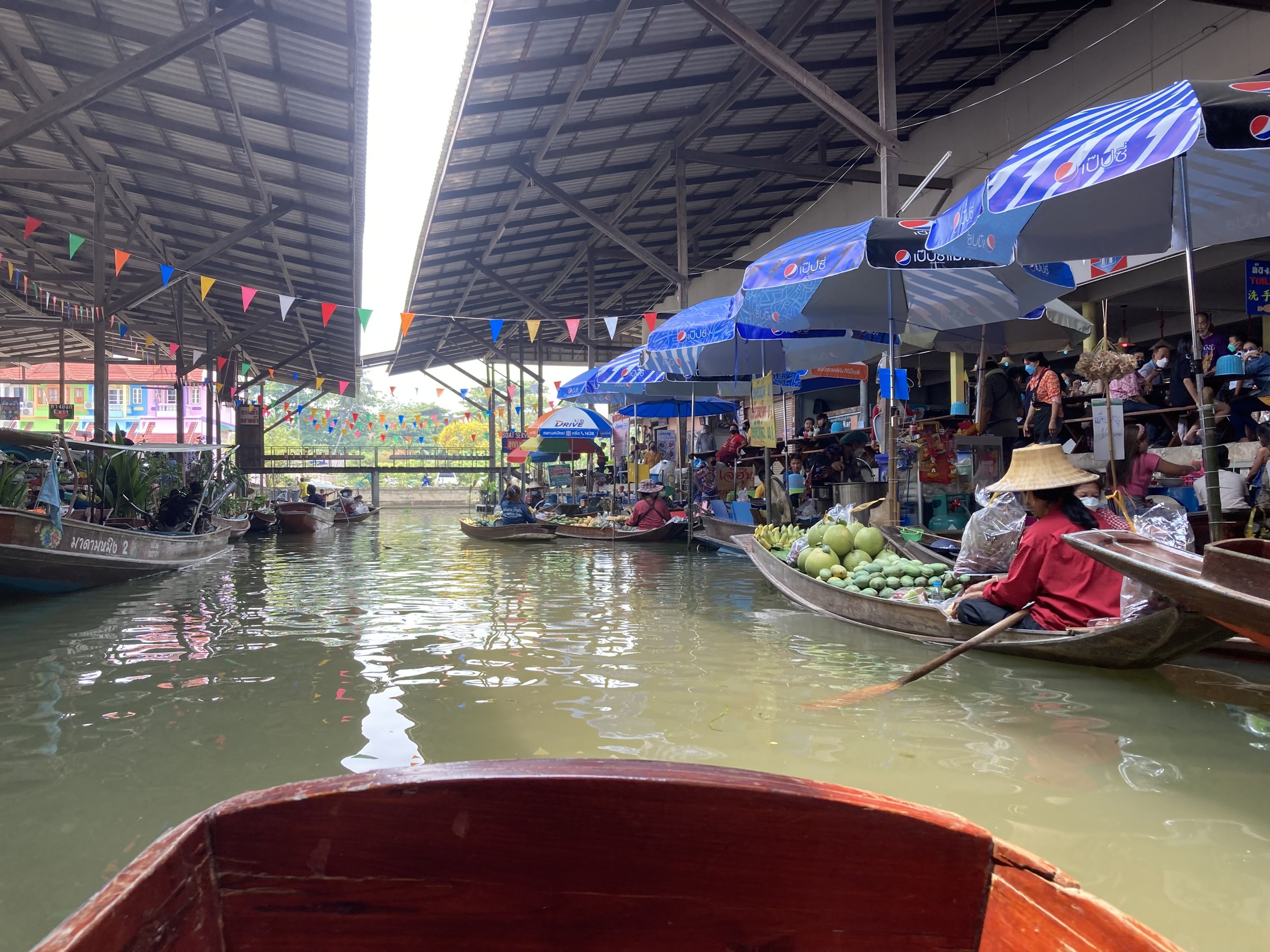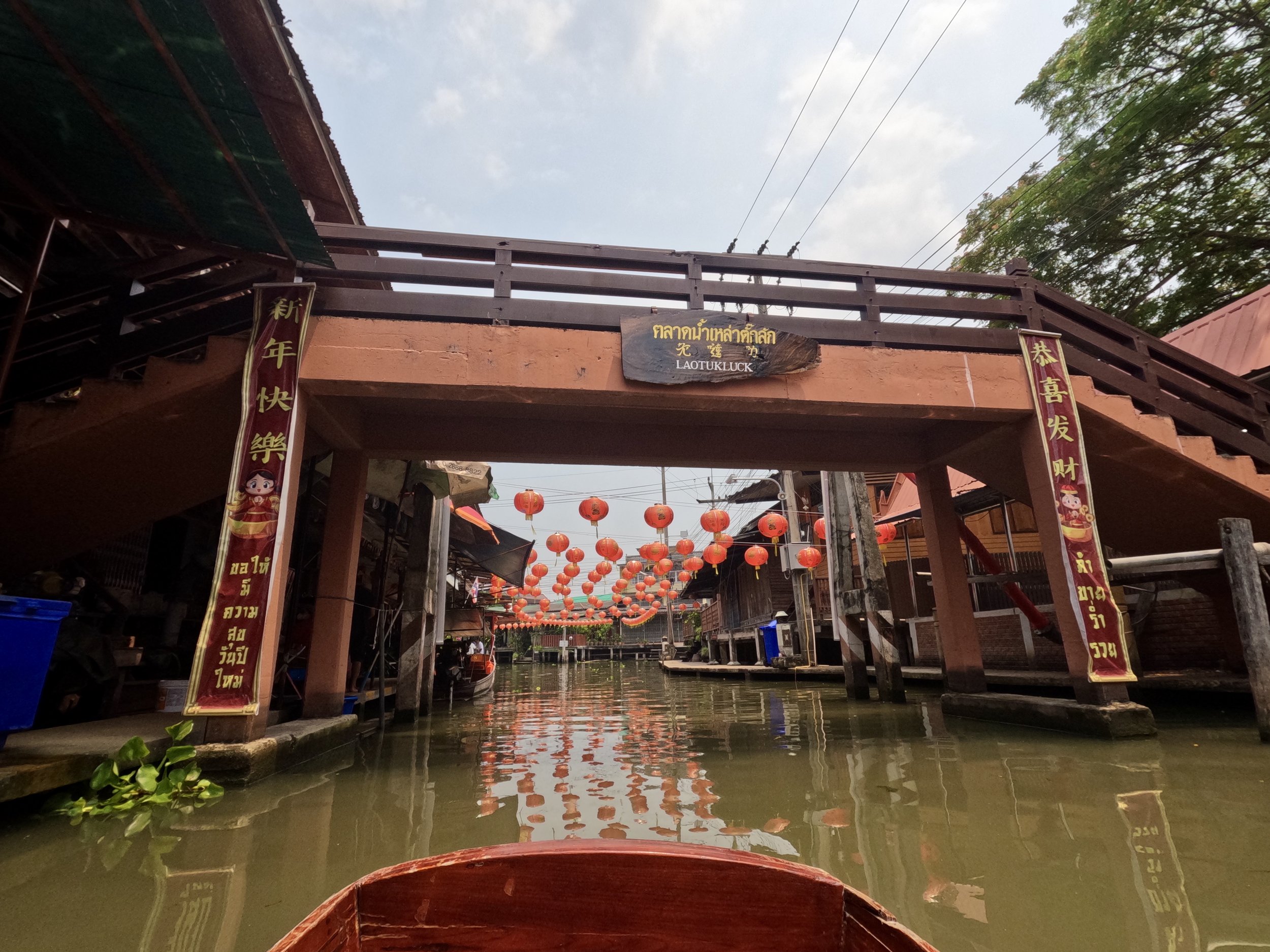Visiting Damnoen Saduak Floating Market, Bangkok
Floating markets have been a long-standing tradition in Thailand that date back to the Ayutthaya Period, where the interconnecting canals were the most efficient way to trade and also provided a space for communities to socialise and celebrate.
Referring to open-air markets on canals or other narrow waterways, local vendors have restored their traditional cultural ties to operate in the modern day. Taking to their long-tail boats to sell their goods, visitors can have the option to purchase hot food, loose produce, and non-food goods such as homeware, textiles or souvenirs straight from the boats.
With over half a dozen floating markets in and around Bangkok, we chose to visit the iconic and popular Damnoen Saduak floating market southwest of Bangkok, which turned out to be one of our favourite experiences from our time living in Thailand.
Are floating markets tourist traps?
Since the rise of tourism in Thailand, the popularity of some of Bangkok’s more famous floating markets have put off some travellers that are looking for more of an ‘off-the-beaten track’ experience. We’re not a fan of crowds ourselves, and were lucky that we came during a time when Thailand tourism was still very low amidst the pandemic. However, we think a visit is well worth it no matter how busy it is, so if you are visiting when tourism is back in full swing, consider asking a tour operator when their least busy days of the week are if you’re flexible with timing, or plan your own self-driving adventure off the main tourist trail.
All of this being said, we actually found that it was a perk that the Damnoen Saduak floating market was well-visited by tourists, as the vendors expected and seemed to benefit from the number of tourists who visited. Vendors had more options for hot/ready and takeaway foods, whereas in markets solely dedicated to locals, you’d find more produce, spices and sauces that are sold in bulk to be taken home to cook with. In this case, we were able to try a few fruits that were sold by the piece, rather than having to purchase fruit by the kg (which we wouldn’t have been able to fit in our pack).
Visiting markets that are popular with tourists mean you have the option to buy more hot and ready food or loose produce by the piece - a purely locals market will have more bulk goods to sell, which is great if you renting somewhere with a kitchen, but not so much if you’re staying in a hotel accomodation.
Another major perk was that most of these markets lie outside of the Greater Bangkok Area, meaning tours are one of the best ways to access them. A popular market means that tours run regularly and provide knowledgeable guides who can help to translate, organise a boat, or answer questions about market standards. Although you may pay out a bit more visiting markets that are known for their tourism, supporting local farmers and businesses is always worth it, especially coming out of the pandemic.
Getting to the Market
Many vendors sell their own locally grown produce. Make sure if you’re buying bananas at this market to watch out for the small, hard seeds. Most commercially grown bananas we buy in the shops have been modified to not have seeds, but you’ll find them here if buying direct from farmers.
Damnoen Saduak is located about an hour and a half southwest of Bangkok city centre in Ratchaburi Province. The most straightforward route follows the Rama II road out of the city, and through the Samut Sakhon and Samut Songkhram provinces, following the Mae Klong River.
If, like us, you aren’t self-driving, the most cost-effective way to experience the market is via a tour. There are some awesome full day and half day trips you can take, most of them operating out of Bangkok’s city centre, but the one that we chose included both the floating market and the Maeklong Railway Market. We really enjoyed this tour and used Get Your Guide, who are our go-tos when we do happen to book a tour (which, although not often, haven’t ever disappointed).
This being said, if tours aren’t your thing, consider hiring out a vehicle to self-drive, or if money isn’t an issue, you can consider hiring out a private taxi or minivan to take you there. The other option would be to use public transport, but keep in mind that there isn’t a direct way to get there, so you’d be relying on a series of trains and buses after going to the outskirts of the city centre. Use Rome to Rio if you’re looking for an interesting adventure such as this.
Scan the QR code to access the tour we used for Get Your Guide!
At the Market
Fresh fruits were a staple part of our diet when living in Thailand, a good offset to the variety of wok-fried food on offer. The pomelos (large round citrus fruits above) were a personal favourite, as were the rose apples (also pictured above) which were refreshing and subtle - both of which you’ll be able to find at Damnoen Saduak.
The Damneon Saduak market comprises of a variety of stalls set up along the various canals and waterways and vendors selling goods within their longtail boats, either gliding along the water or moored up alongside the walkways. You can choose to either walk along the sides of the canals or hiring out a boat and driver to see the goods from the water. If you do visit the market through a tour, the boat hire is usually included within a visit to the market.
You can expect the normal trinkets that Thai markets have on offer set up alongside the canals including Thai printed clothing, shoes, postcards, religious trinkets and Buddhist symbols, as well as hot food stalls which sell traditional Thai food and bunches of local produce like loose fruit.
As always, cash is king in Thailand, so make sure to pack cash with you before you arrive. We didn’t notice many cash machines in the vicinity, so take some out before you go. The price for goods was typical to that in central Bangkok; you’ll be paying anywhere from 30-90 thb per main meal, and if you’re looking to get souvenirs, base how much you bring with you to what you’re hoping to purchase. Bring a smaller amount for wee trinkets (you’ll be looking at 10 thb for a postcard) or more if you’re looking for larger items (100-250 thb for clothing items such as trousers).
Love a Thai market? Check out our guide on Chiang Mai’s Walking Streets, a must-do if you’re headed north after your time in the capital.
Our Experience
As we mentioned above, we got lucky with the timing, as Thailand in early 2022 had not been very busy in comparison with it’s tourism pre-pandemic. However, we noticed that many vendors had been impacted due to downturn in tourism, a huge driver to the Thai economy. Sometimes being in the company of lot of tourists in/around local markets is a good thing… especially for the vendors!
Although we do typically plan day trips ourselves, there are definitely instances where we opt for booking a tour, and we were really glad we did in this case.
As we mentioned above, we went for the 2 for 1 Damnoen Saduak and Maeklong Railway Market through Get Your Guide, and we were really impressed with the tour. Our guide Kiwi was super knowledgeable, and on the bus trip, she told us a lot about local history, all about the markets and what we can expect, and she even taught us a few Thai phrases and customs (including the colours of Thailand and what they represent). We opted to get picked up from our hotel in Sukhumvit and then were dropped off at the River City shopping centre, located centrally on the Chao Phraya River, later that day.
The round trip from the city centre was about 3 hours, and being able to learn more about the area in the comforts of an air conditioned bus with an experienced driver (who was also excellent), made the experience that much better. The markets weren’t very busy because of the low tourism, so although there weren’t as many vendors, we were able to spend more time pursuing the canals in the long-tail boats organised by our tour group, and we were taken through the residential areas around the market towards the site of the old Damnoen Saduak market, Lao Tuk Luck.
The boat journey was a highlight, and we also enjoyed purchasing a few goods that were on offer from the vendors (the coconut ice cream in particular!), and had a couple of our wok-fried favourites in between from a stall along the walkway. Spending about 2 hours at each of the markets, it was a big day out, but very enjoyable and we highly recommend.
We were lucky to get an extended boat trip around some of the residential areas of the canal connections, and we were also taken through the old Damnoen Saduak market, known as Lao tuk luck, marked by red lanterns over the water and locals playing boardgames on the walkways.
If you’re planning on staying for a few days within Bangkok, we definitely recommend taking a visit to one of the floating markets, whether you do it through a tour or plan your own adventure.
Happy Travels,
Sam + Steve
More on Thailand….













With incredible architecture, world-renowned street food and stunning gilded temples, Bangkok surprised us by being one of our favourite cities to date. For travellers wanting to focus on food and culture, these are what we believe to be the best ways to explore the city….